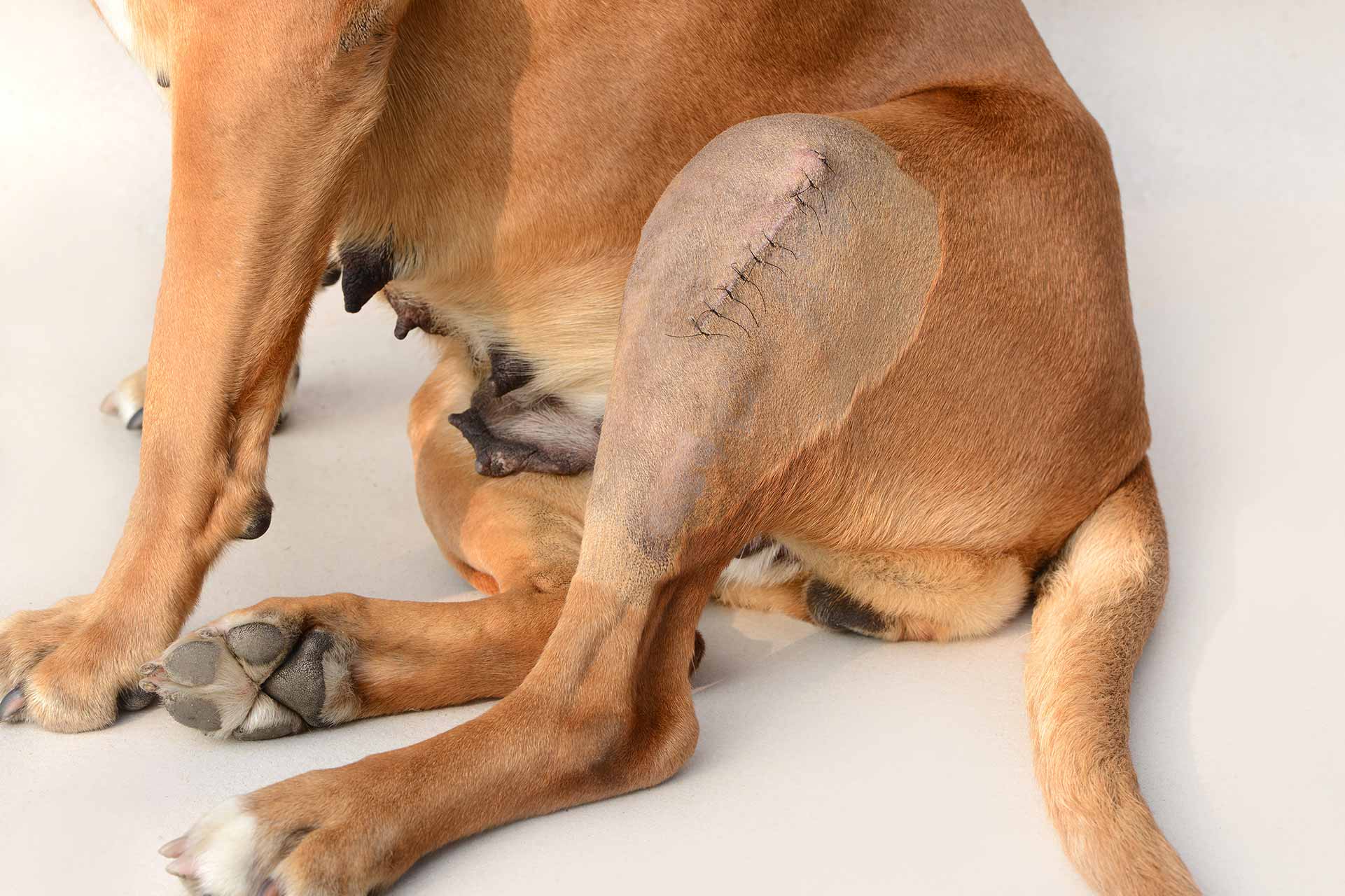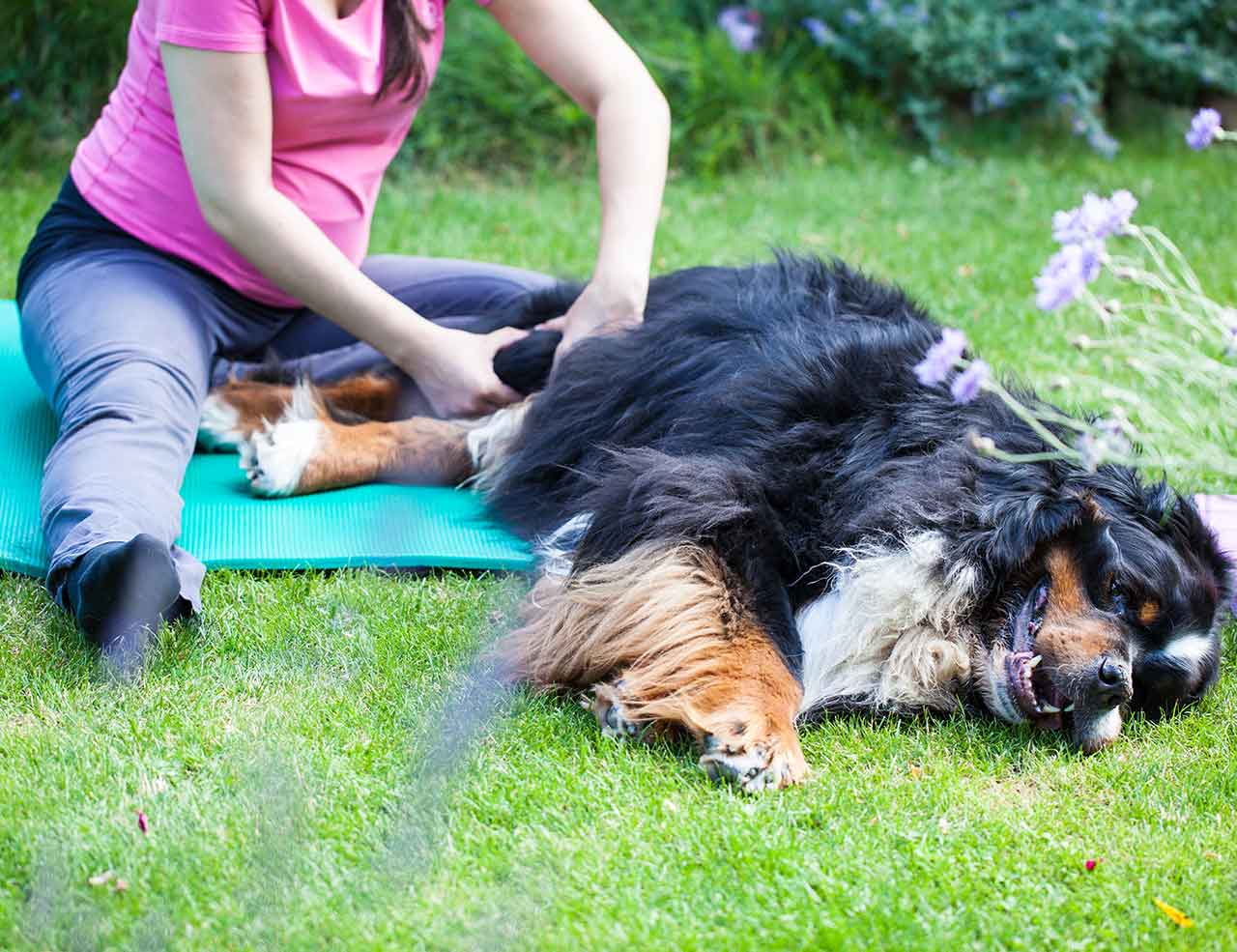What is a Pet Cruciate Ligament Surgery?
The Cruciate Ligament Surgery aims to stop the pain caused by an injured or fully torn cruciate ligament and resume the function of the knee by different surgical techniques.

Why do pets need a Cruciate Ligament Repair?
This injury has various causes.
Especially if your dog is overweight, it risks rupturing its cruciates due to repeated low level injury. If the top of the tibia (the tibial plateau) slopes backwards in your dog’s knee, it puts stress on the cruciate ligament. Repeated low grade stress like this can cause your dog’s ligament to rupture. Even a simple stepping down off the bed or a small jump can be all it takes to finally break your dog’s ligament.
Sometimes when young athletic dogs are playing roughly and take a bad step, this too can injure the knee. Especially in a young large-breed dog it can cause a sudden lameness.
Over time, the pet’s injured knee becomes increasingly unstable. Wear between the meniscal cartilage and bones become abnormal and the joint begins to develop painful arthritis. Bone spurs may develop and this results in chronic pain and loss of motion for your pet.
Symptoms: How to know if a pet requires Cruciate Ligament Repair?
If your dog experiences a sudden, non-weight bearing rear-leg lameness (which does not improve after a short rest), this is most possibly indicative of Anterior cruciate ligament injury. Look out for:

What is MMP cruciate surgery in dogs?
The Modified Maquet Procedure (or MMP surgery) for dogs, is an effective surgery with relatively quick recovery times. The MMP surgery itself is named after Dr Maquet and based on a similar procedure for humans.
MMP surgery takes the pressure off the injured cruciate ligament by redirecting the impact to quadricep muscles. This is accomplished by altering the angle of the tibia (on the lower half of the leg) and shifting it forward to the patellar tendon.
Essentially, a wedge made of porous alloy is placed within the bone and held in place with a single pin. This allows the bone to grow through it. Eventually, the patellar tendon takes over and acts as the CCL.
Surgery Comparison: MMP vs. TPLO?
MMP surgery for dogs is far less invasive than a Tibial Plateau Leveling Osteotomy (TPLO) procedure. It is also less expensive, quicker to perform, and boasts shorter recovery times.
However, in terms of fundamental efficacy, both the TPLO and MMP are effective procedures. Depending on the size, breed and age of your dog, an experienced vet could recommend either.
Recovery & Healing
A quick recovery time is critical for dogs. Dogs don’t understand why they’re injured, or how to take care of an injury – all they know is that they are in pain. So the less time your dog spends in pain, the better.
TPLO usually has a recovery time of about 10 to 12 weeks. Recovery times for MMP are significantly shorter.
While in recovery, both allowing your dog proper time to rest, and limiting physical activity is vital. Your dog should not have access to stairs. It should be prevented from running and jumping. Though it can be difficult, please ensure your dog is kept on a leash for 6 weeks after surgery. This is to make sure that they don’t re-injure their knee with unexpected movements.
Within just 2 days of MMP Surgery, your dog will begin to put some weight on their leg while walking. Over this period, please keep an eye out for any infections, and prevent your dog from licking the area by having them wear a cone.
Roughly 2 weeks after the surgery, the sutures can be removed. From here on, you can take your dog for gentle and slow walks of 5-10 minutes periodically across the day. Your dog should grow comfortable walking on their surgical leg.
After 3 or 4 weeks, you will be able to gradually increase your dog’s activity.
After 5 to 6 weeks, we will do an x-ray to make sure everything is healing according to plan. Once we confirm your dog is on track to recovery, you can walk your dog up to 30 minutes, and start letting them off leash. However, they should only be off leash for about 5 minutes and only as long as there are no other dogs or distractions around.
12 weeks after surgery, your dog should be able to resume pre-injury activity levels.

Prognosis after Cruciate Ligament Surgery for dogs.
The MMP procedure is usually only associated with minor complications like bruising and swelling that mostly go away on their own. In most cases (up to 77% of the time) dogs return to normal within a few months.
Unfortunately though, after tearing one CCL, approximately one-third of dogs will tear the other side. This might mean your dog will eventually need the procedure on the other side.
Thankfully however, MMP surgery is still regarded as an effective solution for CCL failure and can prevent arthritis down the line. It is a great option to keep your dog healthy and active in the long term.
Why Mitcham Vet Hospital?
Dr Hootan Shah has vast experience with Cruciate Ligament Repair and has conducted many procedures.
Mitcham Pet Hospital is well-equipped for surgery and the post-surgery recovery support.
If your dog is experiencing signs of pain, limping, or another injury, talk to us today. Rest assured that your dog is in good hands with our team.

Frequently Asked Questions
Every pet is different. As such, we strongly recommend you regard the following advice as general information only. Call us for any specific enquiries.
Yes. Larger overweight dogs that rupture one cruciate ligament frequently rupture the other one within a year’s time.
Yes. Your pet needs to be monitored to ensure that it is indeed on the path to recovery. Follow-ups could be done either at Mitcham Pet Hospital or at the original referring pet hospital.
A knee replacement is now another option for severely arthritic knees at a surgical specialist.


